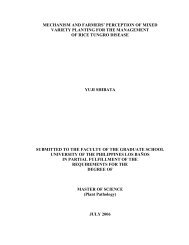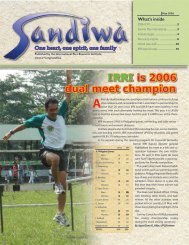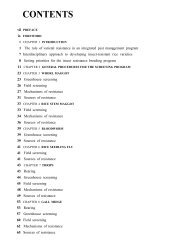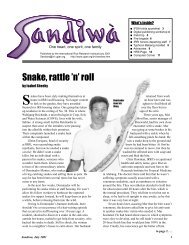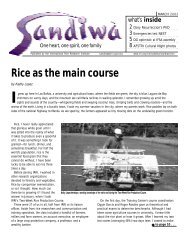Untitled - International Rice Research Institute
Untitled - International Rice Research Institute
Untitled - International Rice Research Institute
Create successful ePaper yourself
Turn your PDF publications into a flip-book with our unique Google optimized e-Paper software.
ange with orange. The pionnotes are wet. On the<br />
reverse side of the agar plate, the colony appears<br />
slightly zonated and becomes azonated toward the<br />
margins. The color is orange to light yellow-orange<br />
toward the margins. At 21 °C under alternating 12-h<br />
NUV light and 12-h darkness, colonies grow fast and<br />
attain a 6.26-cm diam in 5 d. They are azonated with<br />
even margins and pale orange to grayish red.<br />
Pionnotes are wet and appear as reddish orange<br />
small dots. The colony appears azonated to slightly<br />
zonated on the reverse side of the agar plate. The<br />
color is orange interspersed with dull reddish brown.<br />
At 28 °C under alternating 12-h fluorescent light and<br />
12-h darkness, colonies grow relatively fast and attain<br />
a 5.20-cm diam in 5 d. They are zonated with<br />
even margins, floccose, and alternating pale orange<br />
and orange with pale orange mycelial tufts. The<br />
colony appears slightly zonated to zonated and is<br />
alternating orange and light yellow in color on the<br />
reverse side of the agar plate.<br />
Colonies on PSA at ART (28–30 °C) grow relatively<br />
fast and attain a 5.40-cm diam in 5 d. They are<br />
slightly zonated with even margins, slightly felted,<br />
and orange to light yellow-orange, becoming reddish<br />
brown with age. The colony appears slightly zonated<br />
on the reverse side of the agar plate. The color is<br />
orange to bright reddish brown, becoming light yellow-orange<br />
toward the margins. At 21 °C under alternating<br />
12-h NUV light and 12-h darkness, colonies<br />
grow relatively fast and attain a 5.70-cm diam in 5 d.<br />
They are azonated with even margins and slight radial<br />
furrows, felted, and pale orange with shiny reddish<br />
orange pionnotes. The colony appears<br />
azonated to slightly zonated and alternating yelloworange<br />
and orange on the reverse side of the agar<br />
plate. At 28 °C under alternating 12-h fluorescent<br />
light and 12-h darkness, colonies grow relatively<br />
fast and attain a 5.33-cm diam in 5 d. They are<br />
azonated to slightly zonated with even margins,<br />
slightly felted to fluffy, becoming wet with age, and<br />
pale orange to orange. The colony appears slightly<br />
zonated and orange on the reverse side of the agar<br />
plate.<br />
Colonies on MEA at ART (28–30 °C) grow<br />
moderately fast and attain a 4.92-cm diam in 5 d.<br />
They are azonated with even margins, floccose,<br />
and light yellow-orange, becoming powdery with<br />
age. On the reverse side of the agar plate, the<br />
colony appears slightly zonated and pale yellow to<br />
yellow. At 21 °C under alternating 12-h NUV light<br />
and 12-h darkness, colonies grow relatively fast and<br />
attain a 5.18-cm diam in 5 d. They are azonated<br />
with even margins and thin aerial mycelia that are<br />
pressed to the media. The color is pale orange. The<br />
colony appears azonated and dull yellow-orange on<br />
the reverse side of the agar plate. At 28 °C under<br />
alternating 12-h fluorescent light and 12-h darkness,<br />
colonies grow moderately fast and attain a 4.77-cm<br />
diam in 5 d. They are zonated with even margins.<br />
Aerial mycelia are thin and pressed to the media.<br />
The color is pale orange and becomes powdery<br />
with age. On the reverse side of the agar plate, the<br />
colony appears slightly zonated to zonated and the<br />
color is pale orange.<br />
Tilletia barclayana (Bref.) Sacc. & Syd.<br />
syn. Neovossia barclayana Bref.<br />
Tilletia horrida Tak.<br />
Neovossia horrida (Tak.) Padw. & Kahn<br />
Disease caused: kernel smut (bunt)<br />
a. Symptoms<br />
Infected grains show very small black pustules or<br />
streaks bursting through the glumes. When infection<br />
is severe, rupturing glumes produce a short<br />
beak-like outgrowth or the entire grain is replaced<br />
by powdery black mass of smut spores.<br />
b. Occurrence/distribution<br />
The disease is known to occur in many countries<br />
worldwide (Fig. 60).<br />
c. Disease history<br />
In 1986, the causal fungus of this disease was<br />
originally called Tilletia horrida. Later it was<br />
identified as Neovossia barclayana. Further studies<br />
made placed it in the genus Tilletia; it is now<br />
known as Tilletia barclayana.<br />
d. Importance in crop production<br />
The disease can be observed in the field at the<br />
mature stage of the rice plant. It is considered<br />
economically unimportant, causing stunting of<br />
53



